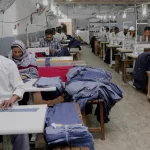Garment exporters have raised concerns over the Government’s recent export figures on the sector saying that the numbers are “inflated” and the situation is not as robust as the official numbers indicate.According to the Directorate General of Commercial Intelligence and Statistics (DGCIS), exports of garments for April-March 2011-12 stood at Rs 65,651 crore compared with Rs 52,917 crore in 2010-11, registering a 24 per cent growth.
But exporters don’t buy this. “There is discrepancy in the numbers that the government has provided. We believe the growth is flat. International buyers are cautious. However, we may get some windfall gain due to appreciating rupee,” Mr Rakesh Vaid, former Chairman of AEPC and also an apparel exporter said.
Re-Look Sought
The garment export sector has been undergoing a severe financial crisis for the last three years due to recessionary trends in US and Euro zone, currency volatility, increasing of bank interest rates, rising freight costs, wage hikes, among others.
Questioning DGCIS numbers, exporters say that they have been asking the Government to re-look at the data as it is a key economic indicator.
“Our order books are extremely sluggish. The export figures for both US and the Europe are exaggerated. The crisis in the Euro zone is affecting business,” another exporter said, adding that they were revising the export forecast.
The Apparel Export Promotion Council (AEPC) Chairman, Mr A. Sakthivel, said, “The exports numbers show a dip in volume but rise in value terms. This may have happened due to various factors including currency volatility and raw material prices.”
He added that about 7-10 per cent people have already lost their jobs in the textile sector in the past two years. The textiles industry employs about 4.5 crore people. For the textile sector, US and the Europe account for as much as 70 per cent of its export market.
AEPC has sought the Government to implement the focus market scheme. “The garment export industry needs look at the initiative in diversifying to non-traditional apparel markets. It can achieve 10 to 15 per cent additional exports if the benefit of two per cent scrip Focus Market Scheme can be given to garment exports to Russia, South Africa, Brazil, South Korea, Japan and Australia for 2012-13,” the nodal body for apparel exports said.
Data from the Confederation of Indian Textile Industry also indicates that textile and clothing production declined by 3.3 per cent during the first half of fiscal April 2011-March 2012. Also the input costs had increased due to rising power tariffs and crude oil prices. CITI also noted that 83 per cent of the 220 listed textile and clothing companies experienced declining profits in the first half of this financial year, compared to the year-earlier period.
Consolidation
However, analysts believe exporters may be seeing weak order books as global retailers are consolidating. Mr Amit Gugnani, Senior Vice-President, Fashion and Textile, Technopak, said, “Consolidation of supplier base has been a key trend with most retailers in the last couple of years. Certain suppliers have grown and will continue to grow over the years while the others have faced issues in capacity utilisation.” Gugnani said that it is the affordability of good fashion for Indian customers that works well. Although, fashion needs to be in a budget, it should also redefine basic needs of the consumers, especially when it comes to quality and design innovation.






